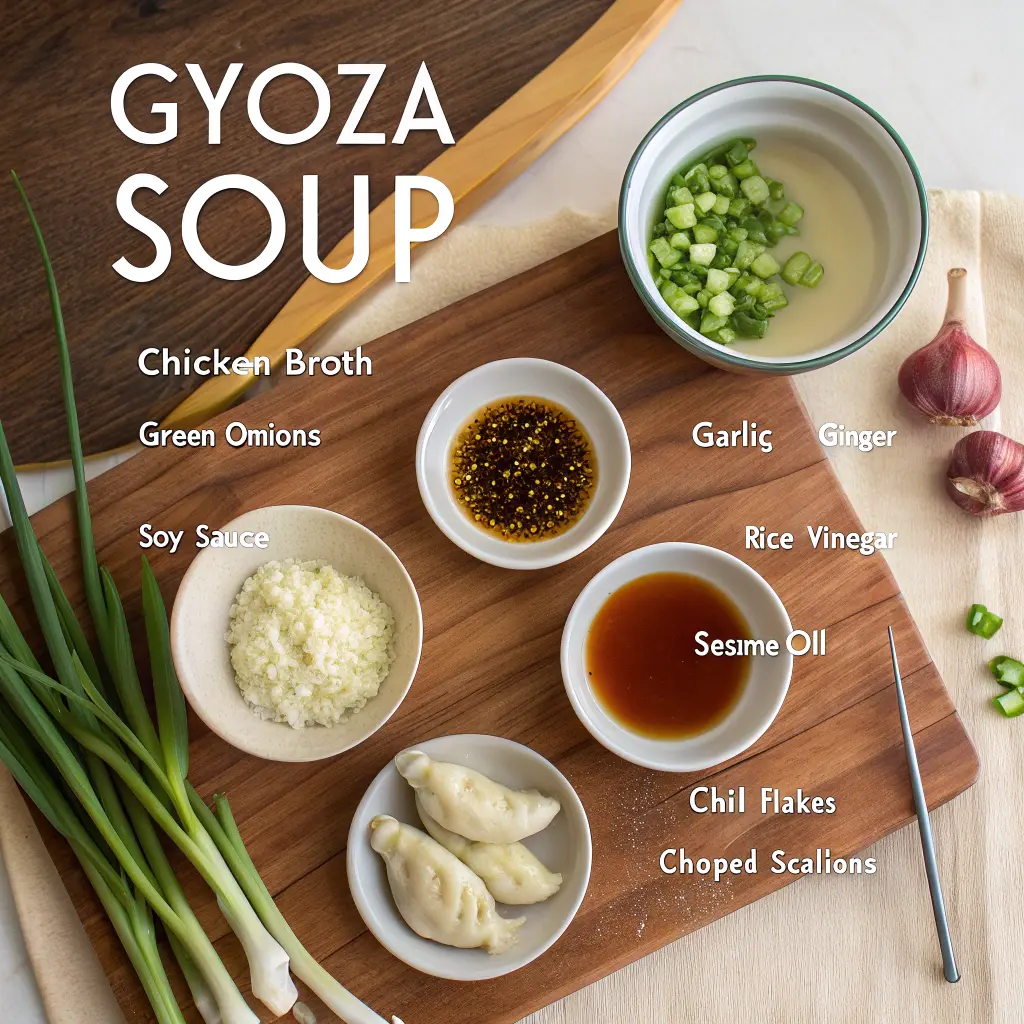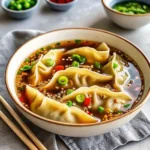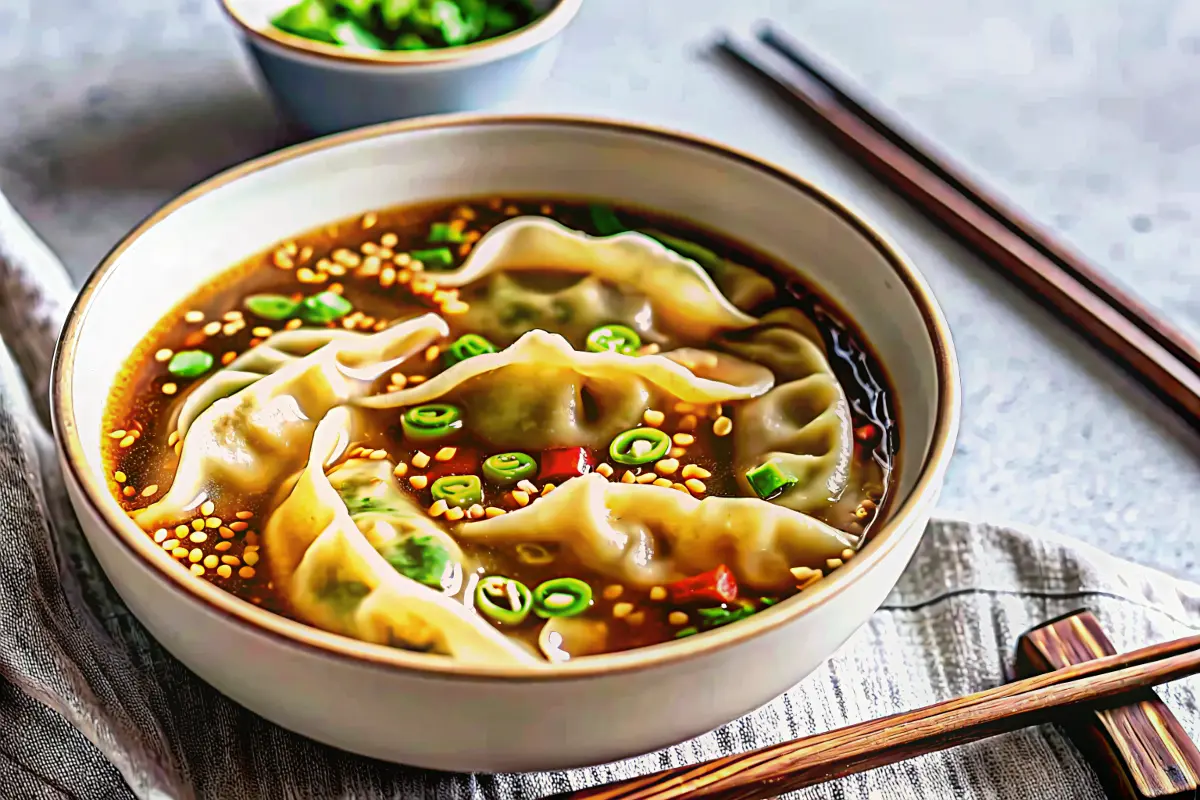What is Gyoza Soup?
Gyoza soup (also called sui gyoza when served boiled in broth) is a Japanese dumpling dish where tender dumplings are simmered in a flavorful stock and served hot. Unlike pan-fried potstickers, which are crisp on the bottom, sui gyoza focuses on delicate wrappers and juicy fillings that absorb the essence of the broth.
This dish evolved as part of Japan’s adaptation of Chinese jiaozi. Over time, Japanese cooks created thinner wrappers, lighter fillings, and introduced broth variations that give gyoza soup its distinctive character. Today, you’ll find it in izakayas, ramen shops, and home kitchens around the world.
Essential Ingredients for Gyoza Soup
Crafting the perfect gyoza soup comes down to three main components:
1. The Broth
The broth is the backbone of the soup. Here are the most common options:
- Dashi – the quintessential Japanese stock made with kombu (seaweed) and katsuobushi (bonito flakes).
- Miso Broth – savory and slightly creamy, adding depth to every bite.
- Chicken or Vegetable Broth – clean and versatile, easy to make at home or buy in cartons.
- Fusion Broths – coconut milk, curry paste, or spicy chili bases for a modern twist.
2. The Gyoza
These dumplings can be:
- Homemade – filled with pork, chicken, shrimp, or vegetables.
- Store-bought frozen – convenient and surprisingly high-quality.
- Specialty gyoza – seafood, spicy kimchi, or vegan fillings.
3. The Extras
To elevate your soup, add:
- Bok choy or napa cabbage
- Shiitake mushrooms
- Spinach or baby greens
- Aromatics like garlic, ginger, scallions
- Garnishes like sesame oil, chili oil, or toasted sesame seeds

Broth Variations: Building the Perfect Base
Your choice of broth sets the tone of the dish. Let’s explore a few versions:
Dashi Broth
- Quick and umami-rich.
- Make from scratch with kombu + bonito flakes, or use instant dashi granules.
- Great for showcasing delicate fillings like shrimp or vegetable gyoza.
Miso Broth
- White miso (shiromiso) is mild and slightly sweet.
- Red miso (akamiso) is bolder, saltier, and earthier.
- Add miso at the end of cooking to preserve its flavor.
Chicken or Clear Broth
- Works beautifully with pork or chicken gyoza.
- Roast bones and simmer with ginger and scallions for depth.
- A flexible option if you’re cooking for a crowd.
Creamy or Fusion Broths
- Coconut milk + red curry paste = spicy, Thai-inspired twist.
- Add lemongrass and lime leaves for brightness.
- Perfect for adventurous palates who want gyoza soup with a kick.
Gyoza 101: Wrappers and Fillings
The dumplings themselves are the highlight of gyoza soup.
- Wrappers: Japanese gyoza wrappers are thinner than Chinese jiaozi. Thin wrappers cook quickly in soup, making them ideal.
- Fillings: Common choices are:
- Pork + napa cabbage
- Chicken + scallion + ginger
- Shrimp + garlic chives
- Vegetarian: tofu, mushrooms, spinach
Step-by-Step: Basic Gyoza Soup Recipe
Here’s the classic, straightforward way to make gyoza soup:
Ingredients (serves 4)
- 6 cups chicken or vegetable broth
- 16 frozen gyoza (pork or chicken recommended)
- 2 cloves garlic, sliced
- 1-inch piece fresh ginger, sliced
- 1 tbsp soy sauce
- 2 cups bok choy, chopped
- 1 cup shiitake mushrooms, sliced
- 2 scallions, finely sliced
- 1 tsp sesame oil
Instructions
- In a large pot, bring the broth to a gentle simmer.
- Add garlic, ginger, and soy sauce. Simmer for 5 minutes to infuse flavor.
- Add frozen gyoza. Cook 4–6 minutes, or until dumplings float and are cooked through.
- Add bok choy and shiitake mushrooms. Simmer for 2 minutes.
- Remove from heat. Stir in sesame oil.
- Ladle soup into bowls and top with scallions before serving.
This is the foundation recipe, and from here you can expand into countless variations.
Step-by-Step: Crispy Pan-Fried Gyoza Soup
Want a mix of crispy and soupy? This method is for you.
Ingredients (serves 2–3)
- 10 fresh or frozen gyoza
- 1 tbsp oil
- 3 cups broth (any variety)
- 1 cup spinach or greens
- 1 scallion, sliced
- Chili oil for garnish
Instructions
- Heat oil in a skillet over medium heat. Place gyoza flat-side down.
- Fry 2–3 minutes until golden brown.
- Add 1/4 cup water, cover, and steam for 3–4 minutes.
- Meanwhile, bring broth to a simmer in a separate pot.
- Transfer crispy gyoza into serving bowls, then ladle broth over.
- Add greens and scallions, garnish with chili oil.

Three Inspired Variations
Miso Gyoza Soup
- Broth: dashi + 2 tbsp white miso (added at the end)
- Add wakame, tofu cubes, shiitake mushrooms
- Works best with vegetable or shrimp gyoza
Coconut-Spicy Gyoza Soup
- Broth: chicken stock + 1 cup coconut milk + 2 tsp red curry paste
- Add bok choy, cilantro, lime wedges
- Works with chicken or pork gyoza
Gyoza Noodle Soup
- Broth: chicken or vegetable stock
- Add ramen noodles or egg noodles
- Timing tip: cook noodles separately, then add gyoza just before serving to avoid mushiness
Make-Ahead and Storage Tips
One of the best parts of gyoza soup is how freezer-friendly it can be. But there are tricks to storing it properly.
- Store broth and dumplings separately to prevent wrappers from getting soggy.
- Freeze dumplings on a tray first (single layer) before bagging them. This prevents them from sticking together.
- Broth can be frozen in airtight containers for up to 2 months.
- Reheat by simmering broth first, then dropping dumplings in to cook fresh.
Pro tip: If you’re prepping a big batch, freeze dumplings raw, not after boiling — they’ll hold texture better in soup later.
Troubleshooting Common Problems
Even seasoned cooks sometimes face issues with dumplings in soup. Here’s how to fix the most common ones:
1. Soggy Wrappers
- Avoid boiling too aggressively; keep the broth at a gentle simmer.
- Cook dumplings just before serving, not hours ahead.
- If you love texture, pan-fry first before adding to broth.
2. Bland Broth
- Layer umami flavors: soy sauce, miso, dried shiitake, kombu.
- Roast bones (if making chicken stock) for deeper flavor.
- Add a drizzle of chili oil or sesame oil at the end.
3. Overcooked or Dry Filling
- Reduce simmer time; dumplings usually only need 3–6 minutes.
- Frozen dumplings take slightly longer but don’t overdo it.
- Use a slotted spoon to remove one dumpling and cut it open to test doneness.
4. Wrappers Breaking Apart
- Seal homemade dumplings tightly with water.
- Avoid overcrowding the pot (dumplings need space).
- Stir gently, only once or twice.
Serving Suggestions and Garnishes
How you finish your gyoza soup makes a big difference in flavor and presentation.
Garnishes to Try
- Thinly sliced scallions
- Chili oil drizzle
- Toasted sesame seeds
- Fresh cilantro or parsley
- Nori strips
- Lime wedges for brightness
Perfect Pairings
Serve your gyoza soup alongside:
- Steamed rice or fried rice
- Pickled vegetables (tsukemono, kimchi, cucumber pickles)
- Tempura vegetables
- Light salads with sesame dressing
Plating Tips
- Use deep bowls so dumplings sit nicely in broth.
- Add garnishes just before serving for vibrant color.
- For photography, keep a few dumplings peeking above the broth surface.
Frequently Asked Questions About Gyoza Soup
Here are some common questions people ask, with straightforward answers:
Q1: How long do you cook gyoza in soup?
Fresh gyoza cook in 2–4 minutes after they float. Frozen gyoza take 4–6 minutes. Always test one to be sure.
Q2: Can you boil gyoza?
Yes. Boiling is a traditional method called sui gyoza. It creates tender dumplings, though they won’t have the crispy bottoms of pan-fried potstickers.
Q3: Can I use frozen gyoza in soup?
Absolutely. Drop them in directly from the freezer. Stir gently, and cook until they float and the filling is hot.
Q4: What’s the difference between gyoza, potstickers, and wontons?
- Gyoza: Japanese dumplings with thin wrappers and light fillings.
- Potstickers: Usually Chinese dumplings, often pan-fried until crisp.
- Wontons: Thinner wrappers, typically served in broth with smaller shapes.
Q5: How do I stop gyoza wrappers turning soggy in soup?
Cook dumplings just before serving and avoid letting them sit in broth too long. Storing broth and dumplings separately also helps.
Conclusion
Few dishes are as versatile, comforting, and customizable as gyoza soup. From the classic miso variation to bold coconut-spicy twists, this dish invites experimentation. Keep broth and dumplings on hand, and you’ll always have the makings of a quick, soul-warming meal.
Print
Gyoza Soup Recipe
- Total Time: PT30M
- Yield: Serves 4
- Diet: Vegan
Description
This Gyoza Soup is a cozy, flavorful bowl of comfort made with tender dumplings simmered in a savory broth with fresh vegetables. Quick and easy to prepare, it’s perfect for busy weeknights or when you’re craving a light yet satisfying meal.
Ingredients
- 12–16 frozen or fresh gyoza (pork, chicken, or vegetable)
- 6 cups chicken or vegetable broth
- 1 tablespoon soy sauce
- 1 tablespoon sesame oil
- 2 cloves garlic, minced
- 1 teaspoon fresh ginger, grated
- 1 cup shiitake mushrooms, sliced
- 1 cup baby spinach or bok choy
- 2 green onions, thinly sliced
- 1 small carrot, julienned
- Optional: chili oil or sesame seeds for garnish
Instructions
- Prepare the broth: In a large pot, heat sesame oil over medium heat. Add garlic and ginger, sauté for 1 minute until fragrant.
- Add vegetables: Stir in mushrooms and carrots, cooking for 2–3 minutes until softened.
- Simmer broth: Pour in chicken or vegetable broth and soy sauce. Bring to a gentle boil.
- Cook gyoza: Add gyoza directly to the simmering broth. Cook for 6–8 minutes (or follow package directions) until gyoza are cooked through and floating.
- Finish soup: Stir in spinach or bok choy until just wilted. Adjust seasoning with more soy sauce if needed.
- Serve: Ladle into bowls, garnish with green onions, sesame seeds, or a drizzle of chili oil. Enjoy warm!
- Prep Time: PT10M
- Cook Time: PT20M
- Category: Soup
- Method: Stovetop
- Cuisine: Japanese-inspired
Nutrition
- Serving Size: 1 bowl
- Calories: 280kcal
- Sugar: 4g
- Sodium: 950mg
- Fat: 11g
- Trans Fat: 0g
- Carbohydrates: 32g
- Fiber: 3g
- Protein: 12g
- Cholesterol: 25mg


1 thought on “Gyoza Soup Recipe: Easy Japanese Dumpling Soup for Cozy Comfort”